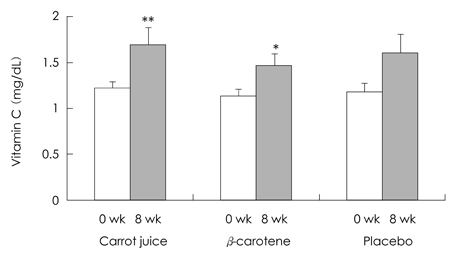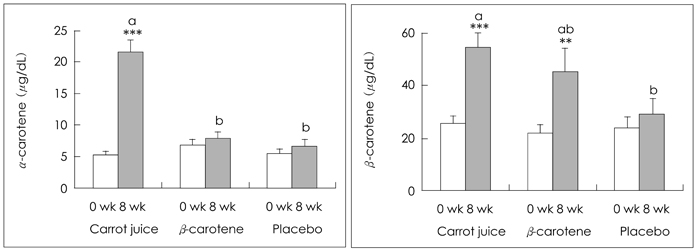Korean J Nutr.
2009 Dec;42(8):750-758.
The Effect of Carrot Juice, beta-carotene Supplementation on Plasma Antioxidant Status of Korean Smokers
- Affiliations
-
- 1Department of Food and Nutrition, College of Life Science & Nano Technology, Daedeok Valley Campus, Hannam University, Daejeon 305-811, Korea. mhkang@hnu.ac.kr
- 2Department of Medical Nutrition, Graduate School of East-West Medical Science, Kyung Hee University, Seoul 130-701, Korea.
- 3Research Institute of Clinical Nutrition, Kyung Hee University, Seoul 130-791, Korea.
Abstract
- Smoking is associated with an increased incidence of numerous cancers and other degenerative diseases. It has been suggested that high consumption of fruits and vegetables may give some protection. Especially carrot is the most important source of dietary beta-carotene. Therefore, the objective of this study is to investigate whether carrot juice supplementation to smokers have different or superior effect of compared to the effect supplementing purified beta-carotene. The study was conducted in a randomized and placebo-controlled design, after a depletion period of 14 days, 48 smokers were supplemented either carrot juice (n = 18), purified beta-carotene (n = 16) or placebo (n = 14). Each group was supplemented for 8 weeks with approximately 20.49 mg of beta-carotene/day and 1.2 mg of vitamin C/day, as carrot juice (300 mL/day) or purified beta-carotene (1 capsule/day). Plasma vitamin C, vitamin E and beta-carotene level were significantly increased after carrot juice and beta-carotene supplementation. These results suggest that carrot juice containing beta-carotene or beta-carotene itself have similar antioxidative potentials by increasing the antioxidant potential in smokers. Therefore, we suggest moderate dose of vitamin supplementation (amount of two servings of vegetable intake) may help to replenish the decreased oxidative stress levels in smokers.
MeSH Terms
Figure
Reference
-
1. Analyses of the Korean National Health and Nutrition Examination Survey. 2007. Ministry for health, welfare and family affairs.2. Park E, Kang MH. Smoking and High Plasma Triglyceride Levels as Risk Factors for Oxidative DNA Damage in the Korean Population. Ann Nutr Metab. 2003. 448(1):36–42.
Article3. Dhawan A, Mathur N, Seth PK. The effect of smoking and eating habits on DNA damage in Indian population as measured in the Comet assay. Mutation Res. 2001. 474(1-2):121–128.
Article4. Gabriel HE, Crott JW, Ghandour H, Dallal GE, Choi SW, Keyes MK, Jang H, Liu Z, Nadeau M, Johnston A, Mager D, Mason JB. Chronic cigarette smoking is associated with diminished folate status, altered folate form distribution, and increased genetic damage in the buccal mucosa of healthy adults. Am J Clin Nutr. 2006. 83(4):835–841.
Article5. Chopra M, O'Nell ME, Keogh N, Wortley G, Southon S, Thurnham DI. Influence of increased fruit and vegetable intake on plasma and lipoprotein carotenoid and LDL oxidation in smokers and nonsmokers. Clin Chem. 2000. 46(11):1818–1829.
Article6. Chiu YW, Chuang HY, Huang MC, Wu MT, Liu HW, Huang CT. Comparison of plasma antioxidant levels and related metabolic parameters between smokers and non-smokers. Kaohsiung J Med Sci. 2009. 25(8):423–430.
Article7. Wang MY, Lutfiyya MN, Weidenbacher-Hoper V, Anderson G, Su CX, West BJ. Antioxidant activity of noni juice in heavy smokers. Chem Cent J. 2009. 3(13):1–5.
Article8. Gill CI, Haldar S, Boyd LA, Bennett R, Whiteford J, Butler M, Pearson JR, Bradbury I, Rowland IR. Watercress supplementation in diet reduces lymphocyte DNA damage and alters blood antioxidant status in healthy adults. Am J Clin Nutr. 2007. 85(2):504–510.
Article9. Sureda A, Tauler P, Aguiló A, Cases N, Llompart I, Tur JA, Pons A. Influence of an antioxidant vitamin-enriched drink on pre- and post-exercise lymphocyte antioxidant system. Ann Nutr Metab. 2008. 52(3):233–240.
Article10. Omenn GS. Chemoprevention of lung cancers: lessons from CARET, the beta-carotene and retinol efficacy trial, and prospects for the future. Eur J Cancer Prev. 2007. 16(3):184–191.
Article11. Albanes D, Heinonen OP, Taylor PR, Virtamo J, Edwards BK, Rautalahti M, Hartman AM, Palmgren J, Freedman LS, Haapakoski J, Barrett MJ, Pietinen P, Malila N, Tala E, Liippo K, Salomaa ER, Tangrea JA, Teppo L, Askin FB, Taskinen E, Erozan Y, Greenwald P, Huttunen JK. α-Tocopherol and β-carotene supplement and lung cancer incidence in the α-tocopherol and β-carotene cancer prevention study: Effects of baseline characteristics and study compliance. J Natl Cancer Inst. 1996. 88(21):1560–1570.
Article12. Duthie SJ, Jenkinson AM, Crozier A, Mullen W, Pirie L, Kyle J, Yap LS, Christen P, Duthie GG. The effects of cranberry juice consumption on antioxidant status and biomarkers relating to heart disease and cancer in healthy human volunteers. Eur J Nutr. 2006. 45(2):113–122.
Article13. Basu A, Imrhan V. Tomatoes versus lycopene in oxidative stress and carcinogenesis: conclusions from clinical trials. Eur J Clin Nutr. 2007. 61(3):295–303.
Article14. Pierce JP, Natarajan L, Sun S, Al-Delaimy W, Flatt SW, Kealey S, Rock CL, Thomson CA, Newman VA, Ritenbaugh C, Gold EB, Caan BJ. Increases in plasma carotenoid concentrations in response to a major dietary change in the women's healthy eating and living study. Cancer Epidemiol Biomarkers Prev. 2006. 15(10):1886–1892.
Article15. Stephens NG, Parsons A, Schofield PM, Kelly F, Cheeseman K, Mitchinson MJ. Randomized controlled trial of vitamin E in patients with coronary disease: Cambridge Heart Antioxidant Study (CHAOS). Lancet. 1996. 347:781–786.
Article16. Boaz M, Smetana S, Weinstein T, Matas , Gafter U, Iaina A, Weissgarten Y, Brunner D, Fainaru M, et al. Secondary prevention with antioxidants of cardiovascular disease in endstage renal disease (SPACE): randomized placebo-controlled trial. Lancet. 2000. 356:1213–1218.
Article17. USDA-Iowa State University. Database on the isoflavone content of foods. 1999. www.nal.usda.gov.18. Kim JS, Yoon S. Isoflavone contents and β-glucosidase activities of soybeans, Meju and Doenjang. Korean J Food Sci Technol. 1999. 31(6):1405–1409.19. Hertog MGL, Hollman PCH, Katan MB. Content of potentially anticarcinogenic flavonoids of 28 vegetables and 9 fruits commonly consumed in the Netherlands. J Agric Food Chem. 1992. 40:237–239.
Article20. Hertog MG, Feskens EJ, Hollman PC, Katan MB, Kromhout D. Dietary antioxidant flavonoids and risk of coronary heart disease: the Zutphen Elderly Study. Lancet. 1993. 342(8878):1007–1011.
Article21. Hertog MG, Kromhout D, Aravanis C, Blackburn H, Buzina R, Fidanza F, Giampaoli S, Jansen A, Menotti A, Nedeljkovic S. Flavonoid intake and long-term risk of coronary heart disease and cancer in the seven countries study. Arch Intern Med. 1995. 155(4):381–386.
Article22. Bilyk A, Cooper L, Sapers GM. Varietal differences in distribution of quercetin and kaempferol in onion tissue. J Agric Food Chem. 1984. 32:274–280.23. Bilyk A, Sapers GM. Distribution of quercetin and kaempgerol in lettuce kale, chive, garlic chive, leek, horseradish, red radish, and red cabbage tissues. J Agric Food Chem. 1985. 33:226–232.24. Park YK, Kim YA, Park EJ, Kim JS, Kang MH. Estimated Flavonoids Intake in Korean Adults Using Semiquantitative Food-frequency Questionnaire. Korean J Nutr. 2002. 35(10):1081–1088.25. The ministry of health and welfare. Food Standard Code. 1995. Seoul, Korea:26. Kim MH, Kim MC, Park JS, Park EJ, Lee JO. Determination of Antioxidants Contents in Various Plants Used as Tea Materials. Korean J Food Sci Thecnol. 1999. 31(2):273–279.27. Pesce AJ, Kaplan LA. Methods in Clinical chemistry. 1987. The C. V. Mosby Co..28. Genser DD, Kang MH, Vogelsang H, Elmadfa I. Status of lipid-soluble antioxidants and TRAP in patients with crohn's disease and healthy controls. Eur J Clin Nutr. 1999. 53:675–679.
Article29. Kang MH, Park EJ. Effects of Smoking and Regular Physical Exercise Habits on the Status of Plasma Lipidsoluble Antioxidant Vitamins and Ubiquinone (Coenzyme Q10) in Korean Middle-aged Men. Korean J Nutr. 2000. 33(2):158–166.30. Gocke N, Keaney JF, Frei B, et al. Long-term ascorbic acid administration reverses endothelial vasomotor dysfunction in patients with coronary artery disease. Circulation. 1999. 99:3234–3240.
Article31. Kallner AB, Hartmann D, Homig DH. On the requirements of ascorbic acid in man: steady state turnover and body pool in smoker. Am J Clin Nutr. 1981. 24:1347S–1355S.32. Eiserich JP, van der Vliet A, Handelmen GJ, Halliwell B, Cross CE. Dietary antioxidants and cigarette smoked-induced biomolecular damage: a complex interaction. Am J Clin Nutr. 1995. 62(6):1490S–1500S.33. You CS, Parker RS, Goodman KJ, Swanson JE, Corso TN. Evidence of cis-trans isomerization of 9-cis-beta-carotene during absorption in humans. Am J Clin Nutr. 1996. 64(2):177–183.
Article34. Kim HY, Lim YI, Russell RM. Changes in Carotenoids Contents in Pureed and Cooked Carrot and Spinach during Storage. Korean J Soc Food Cookery Sci. 2003. 19(1):83–95.35. Livny O, Reifen R, Levy I, Madar Z, Faulks R, Southon S, Schwartz B. Beta-carotene bioavailability from differently processed carrot meals in human ilestomy volunteers. Eur J Nutr. 2002. 4:338–345.36. O'Byrun DJ, Deraraj S, Grundy SM, Ialal I. Comparison of the antioxidant effect of concord grape juice flavonoids and α-tocopherol on markers of oxidative stress in healthy adults. Am J Clin Nutr. 2002. 76:1367–1374.37. Marniemi J, Hakala P, Maki J, Ahotupa M. Partial resistance of low density lipoprotein to oxidation vivo after increased intake of berries. Nutr Metab Cardiovasc Dis. 2000. 10(6):331–337.38. Waldmann A, Koschizke JW, Leitzmann C, Hahn A. Dietary intakes and blood concentrations of antioxidant vitamins in German vegans. Int J Vitam Nutr Res. 2005. 75(1):28–36.
Article39. Muller H, Bub A, Watzl B, Rechkemmer G. Plasma concentration of carotenoids in healthy volunteers after intervention with carotenoid-rich food. Eur J Nutr. 1999. 38(1):35–44.40. Kim CS, Kang HJ, Lee SH, Park YK, Kang MH. The Effect of Alpha-tocopherol Supplementation on the Improvement of Antioxidant Status and Lymphocyte DNA Damage in Postmenopausal Women. Korean J Nutr. 2007. 40(8):709–718.41. Micozzi MS, Brown ED, Edwards BK, Bieri JG, Taylor PR, Khachik F, Beecher GR, Smith JC Jr. Plasma carotenoid response to chronic intake of selected foods and beta-carotene supplements in men. Am J Clin Nutr. 1992. 55(6):1120–1125.
Article42. Winklhofer-Roob BM, Rock E, Ribalta J, Shmerling DH, Roob JM. Effects of vitamin E and carotenoid status on oxidative stress in health and disease. Evidence obtained from human intervention studies. Mol Aspects Med. 2003. 24(6):391–402.
Article
- Full Text Links
- Actions
-
Cited
- CITED
-
- Close
- Share
- Similar articles
-
- The effect of carrot juice, beta-carotene supplementation on lymphocyte DNA damage, erythrocyte antioxidant enzymes and plasma lipid profiles in Korean smoker
- Comparative bioavailability of β-carotene from raw carrots and fresh carrot juice in humans: a crossover study
- The Effects of Green Vegetable Juice (Angelica Keiskei) Supplementation on Plasma Lipids and Antioxidant Status in Smokers
- Comparison of the Protective Effect of Antioxidant Vitamins and Fruits or Vegetable Juices on DNA Damage in Human Lymphocyte Cells Using the Comet Assay
- The Effects of Purple Grape Juice Supplementation on Improvement of Antioxidant Status and Lymphocyte DNA Damage in Korean Smokers




